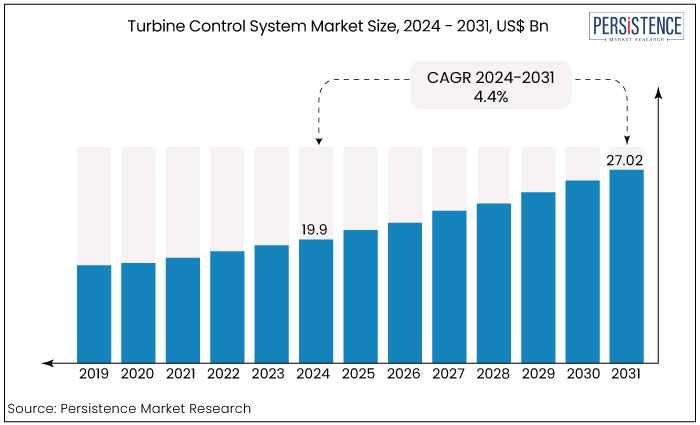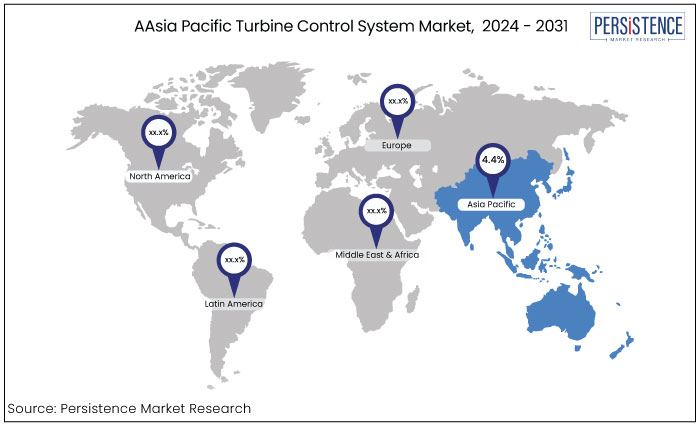Industry: Energy & Utilities
Published Date: September-2024
Format: PPT*, PDF, EXCEL
Delivery Timelines: Contact Sales
Number of Pages: 166
Report ID: PMRREP34804
The global turbine control system market is estimated to increase from US$19.9 Bn in 2024 to US$27.02 Bn by 2031. The market is projected to record a CAGR of 4.4% during the forecast period from 2024 to 2031. The push toward renewable energy including wind and hydropower is a key driving factor for the turbine control system market. Asia Pacific is estimated to dominate the market for turbine control systems owing to the rapid industrialization of emerging economies like India and China.

Key Highlights of the Market
|
Market Attributes |
Key Insights |
|
Turbine Control System Market Size (2024E) |
US$19.9 Bn |
|
Projected Market Value (2031F) |
US$27.02 Bn |
|
Global Market Growth Rate (CAGR 2024 to 2031) |
4.4% |
|
Historical Market Growth Rate (CAGR 2019 to 2023) |
3.4% |
|
Region |
CAGR through 2031 |
|
Asia Pacific |
4.4% |
Asia Pacific market is projected to expand at a CAGR of 4.4% during the forecast period. Asia Pacific leads the turbine control system market owing to the swift establishment of new wind farms necessitating wind turbine control systems for optimal performance.
Heightened investment in infrastructure within the region's developing economies is anticipated to expedite market expansion. In 2023, China dominated Asia Pacific turbine control system primarily due to its rapidly expanding wind farm infrastructure.
India is an economy that substantially enhances regional market expansion, attributed to diverse governmental strategies aimed at transitioning the nation's market towards sustainable energy. India ranks as the third-largest producer of renewable energy globally. India's wind power-producing capacity has significantly increased in recent years.

|
Category |
Market Share in 2024 |
|
Type - Steam Turbine Control System |
45% |
Based on type, the turbine control system market is f divided into steam turbine control system, and gas turbine control system. Among these, the steam turbine control system type dominates the market. The steam turbine control system segment represented 45% of the total market share.
Steam turbines, which transform thermal energy from steam into mechanical power are fundamental to electricity generation particularly in combined-cycle plants and industrial operations necessitating mechanical drive services.
The control system in a steam turbine is essential for regulating its start-up, shutdown, and operational efficiency focusing on the accurate management of steam flow, pressure, and temperature to enhance performance.
|
Category |
Market Share in 2023 |
|
Function - Pressure Control |
32% |
Based on Function, the market for turbine control system is further divided into speed control, temperature control, load control, and pressure control. Among these, the pressure control function dominates the market. The pressure control function category held 32% of the market revenue share.
Pressure control systems are essential for regulating the operational parameters of turbines, particularly in the power generation and processing sectors. In steam turbines, sustaining the appropriate steam pressure is essential for operational efficiency and safety.
Elevated or diminished pressure can profoundly affect the turbine's operation perhaps resulting in mechanical problems or decreased efficiency. Technologies guarantee that turbines function within their specified parameters, therefore optimizing efficiency and extending their operational lifespan.
The industry is experiencing substantial expansion, propelled by the rising demand for energy efficiency and the transition to renewable energy sources. The expansion of this market is further strengthened by technological advancements that offer improved control and operating efficiency for different types of turbines such as gas, steam, and wind turbines.
The incorporation of digital technology and IoT into turbine control systems has facilitated real-time monitoring and predictive maintenance markedly decreasing downtime and improving the performance and longevity of turbines. Siemens' SPPA-T3000 Control System is engineered to enhance the operation of power generation facilities by augmenting their flexibility, reliability, and efficiency.
The need for turbine control systems is being propelled by the retrofitting of antiquated power plants and turbines with contemporary control technology to prolong their operational lifespan and comply with current environmental laws.
The tendency is especially evident in emerging economies, where there is an urgent necessity to enhance current infrastructure to accommodate increasing energy demands while minimizing environmental harm.
Upgrading gas turbine control systems with contemporary solutions such as Emerson's Ovation Turbine Control can markedly improve their efficiency and adaptability, allowing utilities to better address peak needs.
The turbine control system market has experienced significant growth historically driven by the increasing adoption of renewable energy sources such as wind and hydropower, and the modernization of conventional power plants. The market expanded steadily due to the rising need for automation and control systems to optimize turbine efficiency, reduce downtime, and ensure operational safety.
The demand for more sophisticated control systems in gas, steam, and hydro turbines along with advancements in digitalization and real-time data monitoring further fueled market growth.
The turbine control system market is projected to grow robustly from 2024 to 2031 with increasing investments in renewable energy infrastructure and the transition toward low-carbon power generation. The shift toward smart grids, coupled with the need for more efficient and automated turbine operations swill drive future demand.
Asia Pacific is expected to lead market expansion due to rapid industrialization and large-scale energy projects in countries like China and India. The integration of IoT and AI technologies into turbine control systems will offer new avenues for growth.
Rising Adoption of Renewable Energy
The global push toward renewable energy, including wind and hydropower, is a key driver for the Turbine Control System market. As countries work to reduce their carbon footprints and meet climate change goals, investments in renewable energy infrastructure have surged.
Wind turbines and hydropower plants require advanced control systems to ensure optimal performance, reliability, and efficiency in variable weather conditions. Turbine control systems are critical for maintaining consistent power generation, managing load fluctuations, and reducing operational risks in renewable power plants.
Governments worldwide are providing financial incentives and setting renewable energy targets, which are further propelling the demand for turbine control systems.
As renewable energy continues to expand, especially in regions like Europe and Asia-Pacific, the market for turbine control systems is expected to witness significant growth.
Technological Advancements in Automation and IoT
The integration of advanced technologies such as automation, the Internet of Things (IoT), and artificial intelligence (AI) is transforming the turbine control system landscape. These technologies enable real-time monitoring, predictive maintenance, and data-driven optimization of turbine operations enhancing efficiency and reducing downtime.
IoT-enabled turbine control systems provide continuous data on turbine performance allowing operators to identify potential issues before they escalate into costly failures. Predictive maintenance powered by AI further helps extend the lifespan of turbines and optimize energy output.
The shift toward smart and connected turbine control systems is a key growth driver as industries increasingly adopt these technologies to improve power plant operations, enhance safety, and lower operational costs. The growing demand for digitalization in power generation further accelerates the need for advanced control systems.
Technical Challenges and Compatibility Issues
Another major restraint in the Turbine Control System market is the technical complexity and compatibility challenges associated with integrating new control systems into existing power plants. Older turbine systems may not be easily compatible with modern digital control solutions, requiring costly retrofitting or replacement.
The integration process itself can be time-consuming and disruptive, leading to potential operational downtime. These technical barriers can discourage energy producers from adopting newer control systems, particularly in plants where continuous operation is critical.
Differences in system architectures, communication protocols, and turbine types can create compatibility issues, further complicating the implementation process. As a result, technical challenges remain a significant hindrance to the widespread adoption of advanced turbine control systems.
Integration of Artificial Intelligence (AI) and Predictive Maintenance
The incorporation of AI and machine learning in turbine control systems offers one of the most transformative opportunities in the market. AI can analyze large volumes of data generated by turbine sensors, helping operators predict and prevent potential failures through predictive maintenance. This approach minimizes unplanned downtime extends the operational life of turbines, and optimizes energy production.
The ability to forecast equipment issues before they occur is especially valuable in high-investment power generation environments where even a short period of downtime can lead to significant financial losses.
As the energy industry increasingly embraces data-driven solutions, turbine control systems that leverage AI and advanced analytics are set to play a critical role in boosting operational efficiency making this a significant growth opportunity.
Expansion of Offshore Wind Farms
The growing focus on offshore wind energy presents a key opportunity for the turbine control system market. Offshore wind farms are experiencing rapid development globally, driven by their ability to generate more consistent and stronger wind power compared to onshore installations.
The large-scale and complex nature of offshore wind turbines requires advanced control systems to manage the turbines efficiently in challenging marine environments. These systems must ensure reliable performance, monitor turbine health in real time, and optimize energy output under varying wind conditions.
As governments worldwide, especially in Europe and North America, invest heavily in offshore wind projects to meet renewable energy targets, the demand for high-performance turbine control systems designed for these environments will increase.
The turbine control system market is highly competitive featuring several leading players, including Siemens, GE Digital, Honeywell, and ABB. Leading companies dominate the market by offering a broad range of advanced control systems and leveraging their extensive experience in the energy sector. They focus on technological innovation, such as integrating AI and IoT capabilities into control systems to enhance performance and reliability.
Strategic partnerships, mergers, and acquisitions are common as firms aim to expand their product portfolios and geographical reach. Emerging players and regional firms also contribute to market dynamics by targeting niche segments and offering cost-effective solutions. The competitive landscape is characterized by continuous advancements in technology and a strong emphasis on energy efficiency and system integration.
Recent Industry Developments in the Turbine Control System Market
|
Attributes |
Details |
|
Forecast Period |
2024 to 2031 |
|
Historical Data Available for |
2019 to 2023 |
|
Market Analysis |
US$ Billion for Value |
|
Key Regions Covered |
|
|
Key Market Segments Covered |
|
|
Key Companies Profiled in the Report |
|
|
Report Coverage |
|
|
Customization & Pricing |
Available upon request |
By Type
By Function
By Component
By Region
To know more about delivery timeline for this report Contact Sales

The market is estimated to be valued at US$27.02 Bn by 2031.
Asia Pacific is the dominant regional market.
The market is estimated to exhibit a CAGR of 4.4% over the forecast period.
Some of the key players in the market are ABB, Siemens Energy, and Eaton.